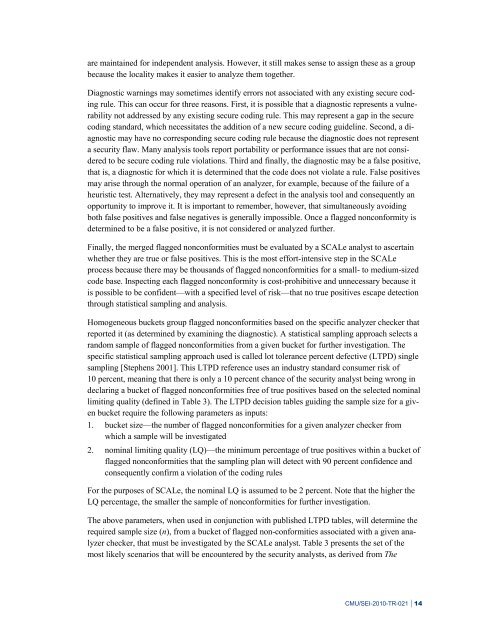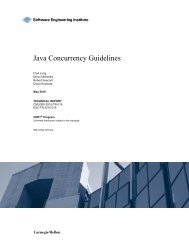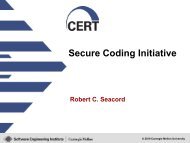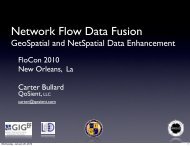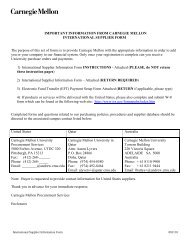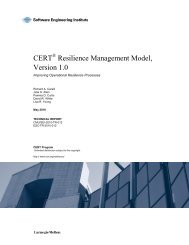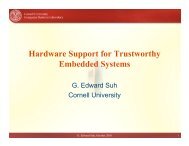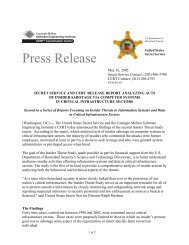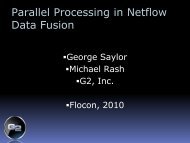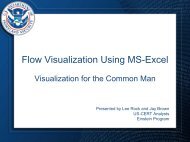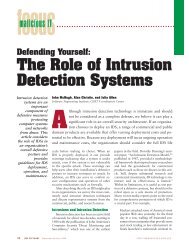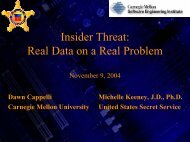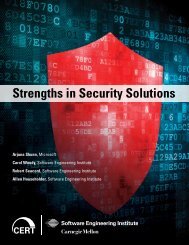Source Code Analysis Laboratory (SCALe) for Energy ... - CERT
Source Code Analysis Laboratory (SCALe) for Energy ... - CERT
Source Code Analysis Laboratory (SCALe) for Energy ... - CERT
You also want an ePaper? Increase the reach of your titles
YUMPU automatically turns print PDFs into web optimized ePapers that Google loves.
are maintained <strong>for</strong> independent analysis. However, it still makes sense to assign these as a group<br />
because the locality makes it easier to analyze them together.<br />
Diagnostic warnings may sometimes identify errors not associated with any existing secure coding<br />
rule. This can occur <strong>for</strong> three reasons. First, it is possible that a diagnostic represents a vulnerability<br />
not addressed by any existing secure coding rule. This may represent a gap in the secure<br />
coding standard, which necessitates the addition of a new secure coding guideline. Second, a diagnostic<br />
may have no corresponding secure coding rule because the diagnostic does not represent<br />
a security flaw. Many analysis tools report portability or per<strong>for</strong>mance issues that are not considered<br />
to be secure coding rule violations. Third and finally, the diagnostic may be a false positive,<br />
that is, a diagnostic <strong>for</strong> which it is determined that the code does not violate a rule. False positives<br />
may arise through the normal operation of an analyzer, <strong>for</strong> example, because of the failure of a<br />
heuristic test. Alternatively, they may represent a defect in the analysis tool and consequently an<br />
opportunity to improve it. It is important to remember, however, that simultaneously avoiding<br />
both false positives and false negatives is generally impossible. Once a flagged noncon<strong>for</strong>mity is<br />
determined to be a false positive, it is not considered or analyzed further.<br />
Finally, the merged flagged noncon<strong>for</strong>mities must be evaluated by a <strong>SCALe</strong> analyst to ascertain<br />
whether they are true or false positives. This is the most ef<strong>for</strong>t-intensive step in the <strong>SCALe</strong><br />
process because there may be thousands of flagged noncon<strong>for</strong>mities <strong>for</strong> a small- to medium-sized<br />
code base. Inspecting each flagged noncon<strong>for</strong>mity is cost-prohibitive and unnecessary because it<br />
is possible to be confident—with a specified level of risk—that no true positives escape detection<br />
through statistical sampling and analysis.<br />
Homogeneous buckets group flagged noncon<strong>for</strong>mities based on the specific analyzer checker that<br />
reported it (as determined by examining the diagnostic). A statistical sampling approach selects a<br />
random sample of flagged noncon<strong>for</strong>mities from a given bucket <strong>for</strong> further investigation. The<br />
specific statistical sampling approach used is called lot tolerance percent defective (LTPD) single<br />
sampling [Stephens 2001]. This LTPD reference uses an industry standard consumer risk of<br />
10 percent, meaning that there is only a 10 percent chance of the security analyst being wrong in<br />
declaring a bucket of flagged noncon<strong>for</strong>mities free of true positives based on the selected nominal<br />
limiting quality (defined in Table 3). The LTPD decision tables guiding the sample size <strong>for</strong> a given<br />
bucket require the following parameters as inputs:<br />
1. bucket size—the number of flagged noncon<strong>for</strong>mities <strong>for</strong> a given analyzer checker from<br />
which a sample will be investigated<br />
2. nominal limiting quality (LQ)—the minimum percentage of true positives within a bucket of<br />
flagged noncon<strong>for</strong>mities that the sampling plan will detect with 90 percent confidence and<br />
consequently confirm a violation of the coding rules<br />
For the purposes of <strong>SCALe</strong>, the nominal LQ is assumed to be 2 percent. Note that the higher the<br />
LQ percentage, the smaller the sample of noncon<strong>for</strong>mities <strong>for</strong> further investigation.<br />
The above parameters, when used in conjunction with published LTPD tables, will determine the<br />
required sample size (n), from a bucket of flagged non-con<strong>for</strong>mities associated with a given analyzer<br />
checker, that must be investigated by the <strong>SCALe</strong> analyst. Table 3 presents the set of the<br />
most likely scenarios that will be encountered by the security analysts, as derived from The<br />
CMU/SEI-2010-TR-021 | 14


